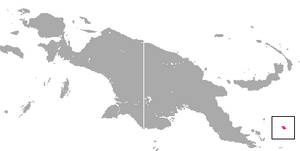Woodlark cuscus facts for kids
Quick facts for kids Woodlark cuscus |
|
|---|---|
| Conservation status | |
| Scientific classification | |
| Genus: |
Phalanger
|
| Species: |
lullulae
|
 |
|
| Woodlark cuscus range | |
The Woodlark cuscus (Phalanger lullulae) is a special type of marsupial that lives only in Papua New Guinea. You can find it on Madau and Woodlark Island, which are part of the Milne Bay Province. It's the biggest mammal living on Woodlark Island! You can also find it on a nearby island called Alcester, about 70 kilometers south.
Contents
What's in a Name?
The first part of its scientific name, Phalanger, comes from a Greek word meaning "spider's web." This name was given because of how their back feet are shaped, with some toes joined together. The second part, lullulae, is a Latin word that means "Woodlark," which is the name of the island where it lives.
How is the Woodlark Cuscus Related to Other Animals?
Scientists study how different animals are related to each other. They use something called a phylogenetic tree to show these relationships. For the Woodlark cuscus, scientists have found that it's related to other cuscuses, like the Eastern common cuscus and the Northern common cuscus. They use different methods, including looking at DNA, to figure out these family connections.
Physical Appearance
The Woodlark cuscus is a medium-sized marsupial. It has dark skin on its face, very small pink ears, and a pink nose. Female cuscuses are usually a little bit bigger than the males.
Skull Features
The skull of the Woodlark cuscus has some unique features. The back part of its skull is not as exposed as in some other marsupials. Its skull is shaped a bit like a pear, and it's widest at the back of its cheekbones. Its teeth, especially the molars, are strong, and its nasal bones extend quite far forward.
Amazing Fur Patterns
One of the coolest things about the Woodlark cuscus is its fur! It's short and looks like marble, with a mix of white, dark brown, and ginger spots on its back. Its belly is white. No two Woodlark cuscuses have the exact same pattern, which makes each one unique!
Cuscuses can be divided into two groups based on their fur color:
- Light morphs: These have more white and ginger colors, with smaller patches of dark fur.
- Dark morphs: These have more dark brown fur, with some patches of white.
Both types have a dark stripe down their back, but it's easier to see on the lighter-colored cuscuses. The fur continues onto the tail, but then it suddenly stops, leaving the end of the tail hairless. This bare part of the tail is dark and a bit rough. It's also a prehensile tail, which means the cuscus can use it to grip branches, almost like a fifth limb!
Where They Live
This cuscus lives in trees, mostly in tropical forests. It prefers dry lowland forests, both old-growth and new-growth areas. People on Woodlark Island say that the Woodlark cuscus hides during the day under plants that grow on trees, called epiphytes, or inside hollows in trees. Since the dry lowland forest covers the eastern part of Woodlark Island, you'll find more cuscuses there than in the dense rainforests on the western side.
Reproduction and Life Cycle
Scientists haven't seen much about how male and female Woodlark cuscuses behave when they mate. However, some interesting things were learned when five female cuscuses were caught in 1987. Some females had young in their pouches, while others had older young riding on their backs. This is normal for marsupials: young cuscuses start in the mother's pouch and then move to her back as they grow.
These observations suggest that the breeding season for Woodlark cuscuses might last a long time. They usually give birth to just one baby at a time. The mother's milk also changes as the baby grows, providing different amounts of nutrients like carbohydrates, fats, and proteins to meet the young cuscus's needs at each stage.
Behavior and Habits
Researchers from Oxford University used radio tracking to study the Woodlark cuscus. They found that these cuscuses are mostly solitary animals, meaning they live alone. They are also nocturnal, which means they sleep during the day and are active at night.
They spend their lives in trees, looking for food in the higher branches and resting in the lower parts of trees. When they are looking for food, they make different sounds to communicate, like barking, snarling, or a whining cry that sounds a bit like a human baby. When they meet each other, they can be quite aggressive. They might eat new growth from trees and vines, and locals say they enjoy the nectar from a fast-growing vine called Rhus taitensis.
Threats and Conservation
For a long time, very few Woodlark cuscuses had been seen, so people thought they were almost extinct. But in 1987, many were found on the eastern part of Woodlark Island and on Alcester Island. Even so, they are still considered endangered by the IUCN (International Union for Conservation of Nature) because they only live in a small area.
Local people do hunt the Woodlark cuscus, but this doesn't seem to affect their numbers much. The biggest threat to these cuscuses is a plan to develop palm oil plantations on the island. Even a small project could harm the native forests where the cuscuses live. Also, if other types of cuscuses were brought to the island, they could compete for food or spread diseases to the Woodlark cuscus.
Images for kids
See also
 In Spanish: Cuscus de la isla Woodlark para niños
In Spanish: Cuscus de la isla Woodlark para niños



